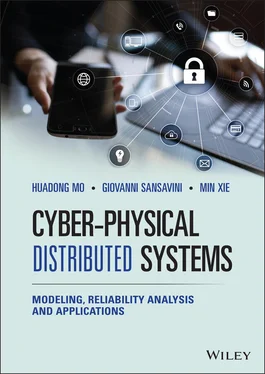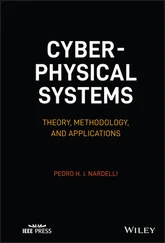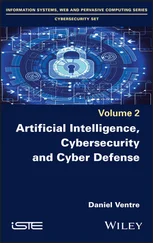Min Xie - Cyber-Physical Distributed Systems
Здесь есть возможность читать онлайн «Min Xie - Cyber-Physical Distributed Systems» — ознакомительный отрывок электронной книги совершенно бесплатно, а после прочтения отрывка купить полную версию. В некоторых случаях можно слушать аудио, скачать через торрент в формате fb2 и присутствует краткое содержание. Жанр: unrecognised, на английском языке. Описание произведения, (предисловие) а так же отзывы посетителей доступны на портале библиотеки ЛибКат.
- Название:Cyber-Physical Distributed Systems
- Автор:
- Жанр:
- Год:неизвестен
- ISBN:нет данных
- Рейтинг книги:3 / 5. Голосов: 1
-
Избранное:Добавить в избранное
- Отзывы:
-
Ваша оценка:
- 60
- 1
- 2
- 3
- 4
- 5
Cyber-Physical Distributed Systems: краткое содержание, описание и аннотация
Предлагаем к чтению аннотацию, описание, краткое содержание или предисловие (зависит от того, что написал сам автор книги «Cyber-Physical Distributed Systems»). Если вы не нашли необходимую информацию о книге — напишите в комментариях, мы постараемся отыскать её.
SYSTEMS
Gather detailed knowledge and insights into cyber-physical systems behaviors from a cutting-edge reference written by leading voices in the field Cyber-Physical Distributed Systems: Modeling, Reliability Analysis and Applications
Cyber-Physical Distributed Systems
Cyber-Physical Distributed Systems
Cyber-Physical Distributed Systems — читать онлайн ознакомительный отрывок
Ниже представлен текст книги, разбитый по страницам. Система сохранения места последней прочитанной страницы, позволяет с удобством читать онлайн бесплатно книгу «Cyber-Physical Distributed Systems», без необходимости каждый раз заново искать на чём Вы остановились. Поставьте закладку, и сможете в любой момент перейти на страницу, на которой закончили чтение.
Интервал:
Закладка:
Recently, AGC has been integrated with open communication networks because of its low cost, high speed, simple structure, and flexible access. Data exchanges among PMUs, generators, and the control center are provided by the open communication network in the form of time‐stamped data packets [42,76,82,83]. Stable AGC depends heavily on the performance of the open communication network [42,76–78,84–88]. Cognitive radio networks, cellular networks, local area networks (LANs), wide area networks (WANs), and wireless local area networks (WLANs) are employed as open communication infrastructures in these NCSs [79,80,83].
However, open communication networks are exposed to various types of degradation processes, such as network‐induced time delays [77,78,86,87], packet dropouts [88,89], failures of the communication infrastructure [90], uncertain communication links [91], and cyberattacks [92]. As a result, the measurement signals (control signals) received by the control center (ESS or generators) degrade, effective AGC cannot be carried out, and the system frequency response worsens [78–82]. Studying the performance of open communication networks is critical for understanding the occurrence of time delays and packet dropouts. To this end, medium access and packet transmission must be analyzed. The MAC layer is the lower layer of the data link layer of the Open System Interconnection model, and it is responsible for moving data packets among network interface cards across communication channels. Several MAC protocols, for example, carrier‐sense multiple access with collision detection (CSMA/CD, Ethernet), CSMA with arbitration on message priority (controller area network), and IEEE 802.11b/g (WLAN), prevent the collision of packets sent from different nodes across the same channel [83,93–95].
Time delays are variable, challenging to predict, deteriorate AGC performance, and reduce the stability region [78,79]. Packet dropouts refer to lost messages, which occupy network bandwidth but cannot reach the destination. They affect the operations of DERs and the reduction of frequency fluctuations, particularly in uncertain network environments. Optimal feedback AGC regulators for DERs have been investigated in numerous works for perfect communication networks, and the impact of transmission delays and packet dropouts on the controller cannot be captured [96]. Robust PID controllers against constant or uniformly distributed time delays [77–80] are designed to cope with perturbations of the control parameters. However, constant or uniformly distributed time delays cannot be generally assumed in realistic communication networks.
In addition, recent studies focusing on primary and secondary control levels have been extended to the power management level by considering fuzzy controllers [97,98], decentralized power management and sliding mode control strategies [99], static synchronous compensators [100], and two‐degrees‐of‐freedom feedback‐feedforward robust controllers [101,102]. The reactive power reference can be determined and controlled by a novel application of radial basis function neural networks [103–105] to improve the power sharing and stability of microgrids with multi‐DERs. To provide high reliability and robustness against network failure or time delays, droop‐based control schemes are designed to specify the frequency of each DER unit by using complementary loops and fuzzy logic controllers [107], robust H ∞controllers [86], and PI controllers [107,108]. On the other hand, novel approaches for mitigating the impact of random time delays quantify robust delay margins [109]. The delay margin‐based sparsity‐promoting wide‐area control strategy, which requires few system observations, can reduce communication requirements and yield nearly optimal performance compared with centralized control [109]. Nevertheless, packet dropout still has the potential to affect the performance of this strategy.
1.2.2 Reliability of CPSs
Distributed renewable energy sources are increasingly connected to power distribution networks as a remedy for environmental and economic concerns [110–112]. However, their power outputs are dependent on the available intermittent natural resources, such as solar irradiation, wind velocity, and biofuel production [113–115]. The rapid deployment and commercialization of storage devices and electric vehicles (EVs) has become an attractive technological solution to facilitate the use of renewable energy sources, manage demand loads, and decarbonize the residential sector [115–117]. The above technological issues call for managing real‐time energy imbalance in DGSs to meet electricity demand over a long‐term horizon. In order to address the challenges of distributed control of energy sources, communication networks are being installed for accurate control of the different power sources and the timely operational scheduling of distributed generator (DG) units, with the objective of providing reliable and sustainable energy in a timely fashion [118–123]. However, most existing research works do not formally investigate the capability of communication networks in providing real‐time power management and promoting the optimal power dispatch [124–127]. The effective integration of communication networks into DG systems is a key step in the realization of future smart grids [90,128].
Most integrated system‐of‐systems models have been developed based on dedicated and closed communication networks, where the infrastructure is exclusively built for smart grid applications [90,128,129]. As the network is dedicated between the DG and the control center, the data exchange is assumed to be perfect and free of defects (e.g., induced time delays and packet dropouts [130–134]). However, experience has shown that dedicated communication networks are ill‐suited to future DG systems, which require a different, more complex but much cheaper network, as its dimension would be much larger [135–137]. Because of the low installation cost, high transmission speed, and flexible access, the open communication network has the highest potential for integration with future DGSs [82,84,138]. As end‐users have to share the limited bandwidth in the open communication networks, which could lead to local congestion, they can be unreliable and suffer from network‐induced delays and packet dropouts [139–141].
Existing research works [42,123,139–146] do not model explicitly and adequately the behaviors of transmission delays and packet dropouts. Most of the aforementioned models are limited to constant or less stochastic transmission delays, which are not true in reality [147,148]. The delays are described by discrete‐time models or are neglected by assuming that they are much smaller than the communication interval [17,123,149,150]. Packet dropouts are usually modeled by a two‐state Markov chain and the associated quantitative loss rates; the detailed state evolution is masked and only input/output information is made available. The state transition matrix is known by assuming that the evolutions of packet dropouts can be fully observed [123,140]. Additionally, the models of uncertain renewable power sources do not consider time‐correlated properties [42,123,139,142,143,151]. Consequently, the control schemes derived based on such assumptions can be very conservative and may not be readily applicable to real systems.
To bridge this gap, a generic and transparent mathematical model is necessary for the analysis of the impacts of integration of unreliable open communication networks (e.g., home area networks, neighborhood area networks, and WANs). The major challenges lie in the modeling and simulation of the interactions between degraded communication networks and DG systems, and the optimization of the real‐time energy management problem on such system platforms. Note that the specific requirements (i.e., high‐frequency data and data prediction) introduced by communication network integration need to be taken into account in this modeling, simulation, and optimization framework.
Читать дальшеИнтервал:
Закладка:
Похожие книги на «Cyber-Physical Distributed Systems»
Представляем Вашему вниманию похожие книги на «Cyber-Physical Distributed Systems» списком для выбора. Мы отобрали схожую по названию и смыслу литературу в надежде предоставить читателям больше вариантов отыскать новые, интересные, ещё непрочитанные произведения.
Обсуждение, отзывы о книге «Cyber-Physical Distributed Systems» и просто собственные мнения читателей. Оставьте ваши комментарии, напишите, что Вы думаете о произведении, его смысле или главных героях. Укажите что конкретно понравилось, а что нет, и почему Вы так считаете.












